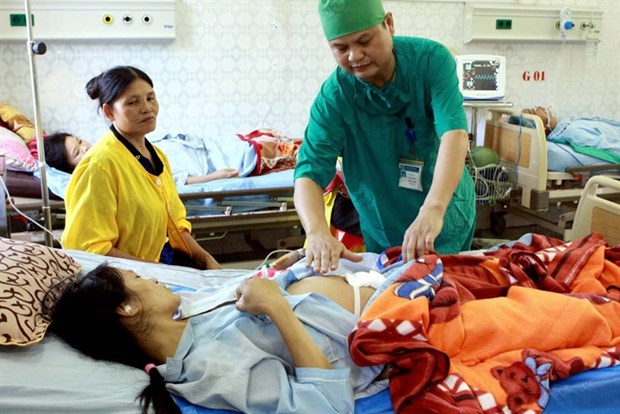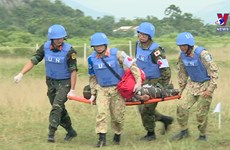VN hospitals fall short of infection control targets
Hospital infection control is a major concern for health care providers and patients all over the world. Preventing such infections is a critical aspect of improving hospital safety, heard a recent conference in Hanoi.
 A patient is treated at Ngoc Lac General Hospital in the central province of Thanh Hoa (Photo: VNA)
A patient is treated at Ngoc Lac General Hospital in the central province of Thanh Hoa (Photo: VNA)Hanoi (VNA) - Hospital infection control is a major
concern for health care providers and patients all over the world. Preventing
such infections is a critical aspect of improving hospital safety, heard a recent
conference in Hanoi.
Addressing a conference on strengthening infection control in healthcare facilities, Deputy Minister of Health Nguyen Viet Tien said hospital infections are an especially significant burden for patients in under-developed and developing countries. Hospital infections contribute to an increase in fatalities, treatment time, usage of antibiotics and cost of treatment.
Statistics from the World Health Organisation (WHO) revealed that the rate of hospital-acquired infections (HAIs) ranges between 3.5 percent and 12 percent in developed countries. For European countries, the rate is 7.1 percent on average, causing about 7 billion EUR (8.6 billion USD) in losses including the costs for treatment and hospital fees.
No specific data about HAIs in developing and under-developed countries was available, but recent studies conducted by WHO showed that HAIs occur more frequently at these countries due to limited resources.
Recognising the important role of hospital infection control in providing successful treatment to patients, Tien said the health sector had adopted measures to tighten infection control at health care facilities, including the issuance of regulations and professional supervision on the issue.
As a result, most hospitals and health clinics started mobilising sources for infection control activities, he said.
The infection control programme had been implemented at healthcare facilities nationwide. Hand hygiene was undisputedly the single most effective control measure for hospital-acquired infections.
However, he admitted that there were several challenges to infection control in Vietnam. The infection control system at healthcare facilities remained incomplete.
Figures from the ministry showed that 16.2 percent of hospitals nationwide failed to establish an infection control department and 26.3 percent failed to assign a head of the department to implement infection control tasks.
Moreover, most health staff at the departments did not receive training, and departments also faced staff shortages. Many hospitals paid inadequate attention to investing in infection control practices as well as equipment so the efficiency of the work was still limited.
Tien said poor infection control contributed to a measles outbreak in April 2014, killing more than 110 children and hospitalising thousands nationwide. It also played a role in the deaths of four pre-term and low birth weight infants at Bac Ninh Hospital of Obstetrics and Pediatrics in November 2017.
To improve the situation, Luong Ngoc Khue, Director of the Ministry of Health’s Medical Examination and Treatment Management Department, said infection control work should be tightened to minimise HAI contraction at hospitals, ensuring the safety of health workers and patients, given the prevalence of such diseases as Avian Influenza (H5N1, H1N1 and H7N9), Middle East Respiratory Syndrome of Corona virus (MERS-CoV) and Ebola.
The health sector would be expected to organise training courses for health staff on infection control and allocate funds for medical equipment to implement infection control practices, he said.
Dissemination campaigns should be adopted to raise awareness among patients and their relatives to improve infection control.-VNA
Addressing a conference on strengthening infection control in healthcare facilities, Deputy Minister of Health Nguyen Viet Tien said hospital infections are an especially significant burden for patients in under-developed and developing countries. Hospital infections contribute to an increase in fatalities, treatment time, usage of antibiotics and cost of treatment.
Statistics from the World Health Organisation (WHO) revealed that the rate of hospital-acquired infections (HAIs) ranges between 3.5 percent and 12 percent in developed countries. For European countries, the rate is 7.1 percent on average, causing about 7 billion EUR (8.6 billion USD) in losses including the costs for treatment and hospital fees.
No specific data about HAIs in developing and under-developed countries was available, but recent studies conducted by WHO showed that HAIs occur more frequently at these countries due to limited resources.
Recognising the important role of hospital infection control in providing successful treatment to patients, Tien said the health sector had adopted measures to tighten infection control at health care facilities, including the issuance of regulations and professional supervision on the issue.
As a result, most hospitals and health clinics started mobilising sources for infection control activities, he said.
The infection control programme had been implemented at healthcare facilities nationwide. Hand hygiene was undisputedly the single most effective control measure for hospital-acquired infections.
However, he admitted that there were several challenges to infection control in Vietnam. The infection control system at healthcare facilities remained incomplete.
Figures from the ministry showed that 16.2 percent of hospitals nationwide failed to establish an infection control department and 26.3 percent failed to assign a head of the department to implement infection control tasks.
Moreover, most health staff at the departments did not receive training, and departments also faced staff shortages. Many hospitals paid inadequate attention to investing in infection control practices as well as equipment so the efficiency of the work was still limited.
Tien said poor infection control contributed to a measles outbreak in April 2014, killing more than 110 children and hospitalising thousands nationwide. It also played a role in the deaths of four pre-term and low birth weight infants at Bac Ninh Hospital of Obstetrics and Pediatrics in November 2017.
To improve the situation, Luong Ngoc Khue, Director of the Ministry of Health’s Medical Examination and Treatment Management Department, said infection control work should be tightened to minimise HAI contraction at hospitals, ensuring the safety of health workers and patients, given the prevalence of such diseases as Avian Influenza (H5N1, H1N1 and H7N9), Middle East Respiratory Syndrome of Corona virus (MERS-CoV) and Ebola.
The health sector would be expected to organise training courses for health staff on infection control and allocate funds for medical equipment to implement infection control practices, he said.
Dissemination campaigns should be adopted to raise awareness among patients and their relatives to improve infection control.-VNA













